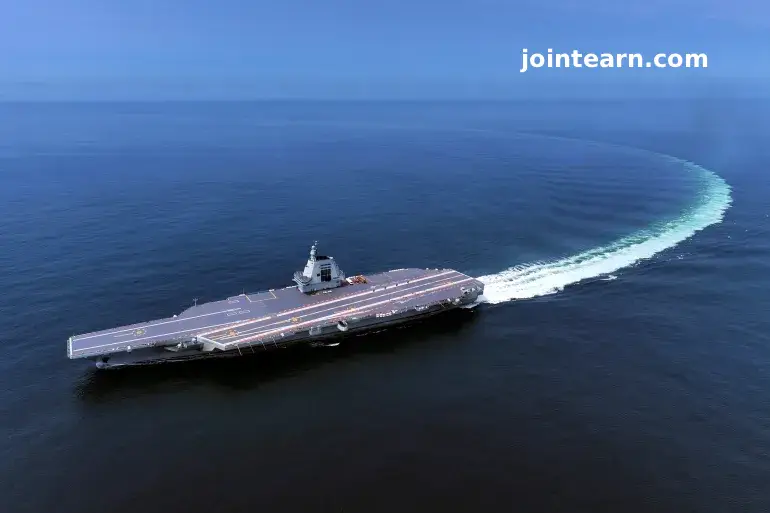
Fujian Officially Enters Military Service
China has officially commissioned its third aircraft carrier, the Fujian, into active military service after completing extensive sea trials, state media reported on Friday.
The Fujian—named after the coastal province opposite Taiwan—represents a monumental step in President Xi Jinping’s efforts to transform the People’s Liberation Army (PLA) into a world-class fighting force capable of projecting power far beyond China’s shores.
According to the Xinhua News Agency, President Xi Jinping personally boarded the carrier on Wednesday for an inspection ceremony at Sanya Naval Base in southern Hainan province, underscoring the ship’s strategic importance to China’s growing blue-water navy.
More than 2,000 naval officers, engineers, and shipbuilders attended the carrier’s commissioning and flag-presentation ceremony, a symbolic event marking China’s emergence as a global maritime power.
Fujian: China’s First Fully Indigenous Supercarrier
Unlike China’s first two carriers, Liaoning and Shandong—which were based on older Soviet designs—the Fujian is the first aircraft carrier entirely designed and built in China.
The vessel features a flat flight deck equipped with electromagnetic catapult launch systems (EMALS) — an advanced technology previously exclusive to the US Navy’s Ford-class carriers. This system allows the Fujian to launch heavier, more advanced aircraft more efficiently than the ski-jump ramps used on its predecessors.
With these upgrades, analysts say the Fujian will be able to carry more aircraft with greater payloads, including stealth fighters and reconnaissance planes, giving China a new level of operational flexibility and long-range combat power.
During its trials, the Chinese navy successfully launched the J-35 stealth fighter, the KJ-600 early warning aircraft, and a modified J-15 fighter jet, demonstrating the ship’s next-generation capabilities.
Strategic Power Projection Beyond China’s Coast
Experts say the Fujian represents not just a technological milestone, but a symbol of China’s expanding global reach and military modernization under President Xi.
“Aircraft carriers are key to Chinese leadership’s vision of China as a great power with a blue-water navy,” said Greg Poling, director of the Asia Maritime Transparency Initiative at the Center for Strategic and International Studies (CSIS).
Poling explained that while China’s navy is already dominant within the First Island Chain—which includes the South China Sea, East China Sea, and areas around Taiwan, Japan, and the Philippines—the Fujian is designed to challenge US dominance deeper into the Indo-Pacific region.
“A carrier doesn’t really help you in the First Island Chain, but it’s key to that contest, if you want one, with the Americans in the wider Indo-Pacific,” Poling noted.
The Fujian’s ability to carry its own airborne early-warning aircraft also means it can operate independently of land-based support, a significant leap forward in long-range naval operations.
Xi Jinping’s Goal: A ‘World-Class’ Military by 2050
The commissioning of the Fujian aligns with Xi Jinping’s long-term vision to build a fully modernized PLA by 2035 and a world-class military rivaling the United States by 2050.
Under Xi, China has expanded its naval fleet to become the largest in the world, both in terms of the number of ships and overall tonnage.
The Fujian stands as the clearest demonstration yet of China’s determination to bridge the technological and operational gap with Western naval powers.
Observers see the carrier as both a symbol of national pride and a strategic instrument in Beijing’s broader ambitions — including its territorial claims in the South China Sea and its pledge to reunify Taiwan.
Fujian’s Capabilities at a Glance
| Feature | Description |
|---|---|
| Type | Conventional-powered aircraft carrier |
| Displacement | Estimated 80,000–85,000 tons |
| Launch System | Electromagnetic Catapult (EMALS) |
| Aircraft Capacity | Estimated 60+ aircraft |
| Main Aircraft | J-35 stealth fighter, J-15 fighter, KJ-600 AEW plane |
| Builder | China State Shipbuilding Corporation (CSSC) |
| Base | Sanya Naval Base, Hainan |
These features make the Fujian comparable in sophistication to some of the most advanced carriers in the world, narrowing the technological gap between China’s navy and that of the United States.
Regional Implications: Rising Tensions in the Indo-Pacific
The introduction of the Fujian is expected to further intensify geopolitical competition in the Indo-Pacific, where tensions between China, the US, Japan, and the Philippines continue to rise.
The carrier’s launch follows a series of joint military exercises by the United States, Japan, and Australia, designed to reinforce freedom of navigation and counter Beijing’s growing maritime assertiveness.
Analysts believe that the Fujian’s deployment will extend China’s reach across the Pacific and Indian Oceans, potentially altering the strategic balance of power in Asia.
Looking Ahead: Fujian’s Road to Combat Readiness
While the Fujian has officially entered service, experts caution that it may take several years before the ship and its crew achieve full combat readiness.
The process of training pilots, perfecting flight operations, and integrating new aircraft into carrier groups is complex and time-consuming, even for advanced navies.
Still, the commissioning of the Fujian sends a clear message: China’s naval modernization is accelerating, and its ambitions to operate on the global stage are stronger than ever.
Conclusion: Fujian and the Future of China’s Navy
The Fujian’s commissioning marks a turning point in Chinese naval history, symbolizing a new era of technological innovation and maritime projection.
As China positions itself as a maritime superpower, the Fujian stands as both a tool of deterrence and a manifestation of Xi Jinping’s vision of China’s “great rejuvenation” — one where Beijing no longer looks inward but projects confidence across the world’s oceans.


Leave a Reply